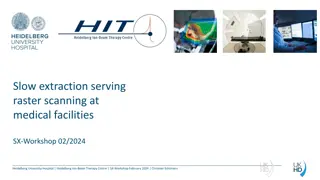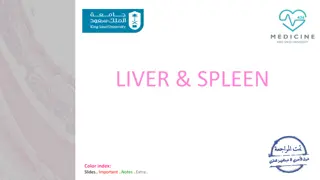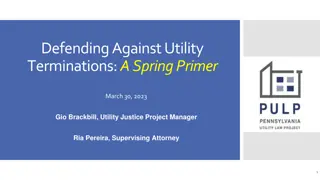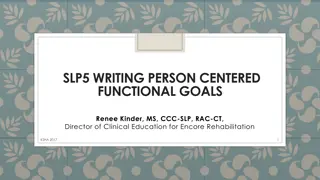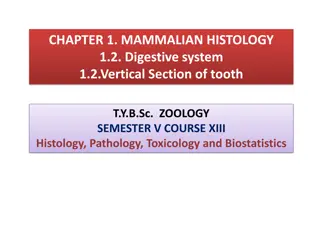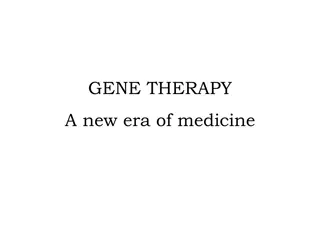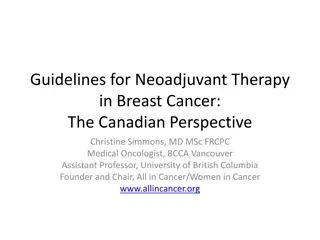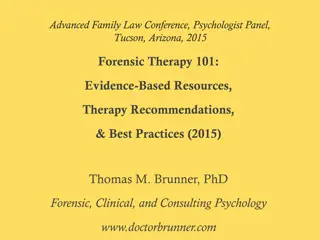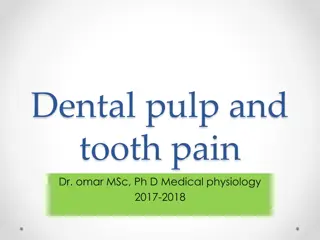Overview of Vital Pulp Therapy
Vital pulp therapy aims to preserve damaged pulp tissue, promoting reparative dentin formation for tooth preservation. Explore its history, diagnosis, prognosis, and relevant considerations for effective treatment.
Download Presentation

Please find below an Image/Link to download the presentation.
The content on the website is provided AS IS for your information and personal use only. It may not be sold, licensed, or shared on other websites without obtaining consent from the author.If you encounter any issues during the download, it is possible that the publisher has removed the file from their server.
You are allowed to download the files provided on this website for personal or commercial use, subject to the condition that they are used lawfully. All files are the property of their respective owners.
The content on the website is provided AS IS for your information and personal use only. It may not be sold, licensed, or shared on other websites without obtaining consent from the author.
E N D
Presentation Transcript
VITAL PULP THERAPY VITAL PULP THERAPY DR. RHYTHM 1
INTRODUCTION INTRODUCTION Vital pulp therapy is broadly defined as treatment initiated to preserve and maintain pulp tissue in a healthy state, tissue that has been compromised by caries, trauma, or restorative procedures. The objective is to stimulate the formation of reparative dentin to retain the tooth as a functional unit. This is particularly important in the young adult tooth, where apical root development may be incomplete. The focus is directed toward the preservation of the pulpally involved permanent tooth permanent tooth, based on the premise that pulp tissue has an innate capacity for repair in the absence of microbial contamination. 2
The first documented instance of vital pulp therapy is attributed to Phillip Pfaff Phillip Pfaff in 1756. 1756. He placed gold foil against an exposed pulp with the intention to promote pulpal healing. 3
DIAGNOSIS AND PROGNOSIS OF DEEP CARIOUS LESIONS Consideration has to be given to: Reparative capacity of the P-D organ Soundness of dentin Reparative capacity of unsound attacked dentin Any degeneration of the P-D organ Sealabilty of restorative materials to be used Potential of any further damage.
PAIN Spontaneous/induced, duration of pain, severity after removal of stimulus RADIOGRAPHS Indicates proximity of carious lesion to pulp chamber and RDT Calcifications, which denotes consumption of and reduction of reparative capacity.
Thickening of periodontal ligament space. Size of pulp chamber as compared to size of tooth. Higher the pulp size/tooth size ratio, better is the reparative capacity. The relative size of the apical foramen to that of the pulp and root canal systems, higher the ratio is, better is the reparative potential.
The size of the pulp exposure relative to dimensions of pulp chamber. PULP TESTING A. Thermal pulp testing B. Electric pulp testing DIRECT PULP EXPOSURE A pin-point exposure having sound dentin at the periphery of exposure with no hemorrhage indicates no or mild pulpal inflammation.
A pin point exposure having sound dentin at periphery but accompanied by a drop of blood that coagulates immediately no or mild inflammation. An exposure having decayed dentin- considerable inflammation and has doubtful reparative capacity. Profuse hemorrhage-indicates mechanical involvement of pulpal and root canal tissues.
Exposure accompanied by inflammatory fluids or pus is evidence of extensive inflammation and destruction of pulpal tissues- P-D organ is definitely beyond repair. Lower the ratio of exposure diameter relative to dimensions of pulpal and root canal tissues- greater is possibility of repair.
PERCUSSION SENSTIVITY It is of little value in determining the degree of inflammation, depends on extent of inflammation. TYPE OF DENTIN Visual examination and tactile evaluation can give an idea about the type of dentin.
REMOVAL OF TOOTH STRUCTURE WITHOUT ANESTHESIA It is a painful but painful method of determining pulp vitality. USE OF DYES 0.5% basic fuschin in propylene glycol to dentin for 10 seconds, infected dentin stains red. The repairable/affected dentin with intact collagen bands and will not get stained.
DIRECT PULP CAPPING In case of mechanical exposure during removal of decay, DPC can be done under following conditions: A. There are no signs or symptoms of degeneration of P-D organ B. The exposure has following characteristics: a. Pin-point/small relative to the pulp size. No hemorrhage or immediate clotting of hemorrhage.
c. The dentin at periphery is reparable/sound. d. Field of operation is completely aseptic.
Proper case selection, based on a new understanding of inflammatory mechanisms responsible for producing irreversible changes in pulpal tissue, can help identify teeth with a greater likelihood for favorable outcomes. The challenge is to identify a reliable pulp capping or pulpotomy agent and a suitable delivery technique. The outcome of vital pulp therapy will depend on The outcome of vital pulp therapy will depend on the age of patient, the size of pulp, bacterial contamination, pulp capping material, and quality of final restoration. 14
According to the American Academy of Pediatric Dentistry American Academy of Pediatric Dentistry, Teeth exhibiting provoked pain of short duration, that is relieved, upon the removal of the stimulus, with analgesics, or by brushing, without signs and symptoms of irreversible pulpitis, have a clinical diagnosis of reversible pulpitis and are candidates for vital pulp therapy A diagnosis of reversible pulpitis increases the probability of a favorable outcome. 15
The outcome of treatment for direct pulp capping or pulpotomy will be determined by the - initial diagnosis (radiographic evaluation, pulp testing, clinical evaluation, and patient history) The intention is to postpone more aggressive therapies that could eventually lower the long-term prognosis for tooth retention and function. 16
WHY VITAL PULP THERAPY IS IMPORTANT The pulp performs several important functions, including -dentinogenesis, -immune cell defense, -nutrition and -proprioreceptor cognizance. The retention and maintenance of the dental pulp are crucial to the long-term function of the tooth 17
Circulating immunocompetent cells limit microbial challenges, and functioning proprioceptors and pressoreceptors guard against excessive occlusal loading. Structurally compromised teeth that have been endodontically treated and restored with various post and core systems are more susceptible to fracture and failure owing to the loss of protective mechanisms. Although studies show that the loss of moisture from dentin after endodontic therapy is minimal, cumulative loss of tooth structure is implicated in the failure of root-treated teeth 18
OBJECTIVE/GOAL.. OBJECTIVE/GOAL .. The reformation of a protective dentinal bridge protective dentinal bridge by tertiary dentinogenesis is a primary goal of vital pulp therapy. The repair of pulpodentinal defects is orchestrated by the migration of granulation tissue to the site from the cell-rich and deep pulp subodontoblastic layers that differentiate into new odontoblast-like cells. Although these progenitor cells are most likely derived from undifferentiated mesenchymal cells, other cell populations migrating via the bloodstream, such as bone marrow stem cells and perivascular cells, have been proposed as possible precursors. Apexogenesis Apexogenesis of the immature adult tooth is one of the key objectives in vital pulp therapy. 19
Odontoblastic process Predentin Cell bodies Odontoblasts Cell-free zone Cell-rich zone 20 (P (P- -D COMPLEX) D COMPLEX)
The migration and proliferation of these cells were studied in nonhuman primates after direct pulp capping with calcium hydroxide (Ca(OH)2). At the calcium hydroxide-pulp interface, a continuous influx of newly differentiating odontoblast-type cells with initial matrix formation was observed as early as day 8. Labeled odontoblast-like cells showed differences in cell types and grain counts between zones, indicating that at least two deoxyribonucleic acid (DNA) replications had occurred between initial treatment and differentiation. Fitzgerald M, Chiego DJJ, Heys DR. Autoradiographic analysis of odontoblast replacement following pulp exposure in primate teeth. Arch Oral Arch Oral Biol Biol 1990 21
Studies have suggested that the mineralization of dentin bridges is more dependent on the extracellular matrix than the pulp capping or pulpotomy material. Oguntebi BR, Heaven T, Clark AE, Pink FE. Quantitative assessment of dentin bridge formation following pulp-capping in miniature swine. J J Endod Endod 1995 Inoue H, Muneyuki H, Izumi T, et al. Electron microscopic study on nerve terminals during dentin bridge formation after pulpotomy in dog teeth. J J Endod Endod 1997 22
I. DIRECT PULP CAPPING I. DIRECT PULP CAPPING Direct pulp capping Direct pulp capping is defined as the "treatment of an exposed vital pulp by sealing the pulpal wound with a dental material placed directly on a mechanical or traumatic exposure to facilitate the formation of reparative dentin and maintenance of the vital pulp. INDICATIONS Exposures as a result of caries removal, tooth preparation, or trauma. CONTRAINDICATIONS Pulp tissue, jeopardized by a long-standing exposure to oral microorganisms and acute inflammation, may be unsuitable for direct pulp capping. Carious exposure of a primary tooth 23
Factors Affecting Prognosis Of Direct Pulp Capping Factors Affecting Prognosis Of Direct Pulp Capping -Mechanical exposures have a better prognosis than carious exposures -Size of exposure -Time gap 25
II. INDIRECT PULP CAPPING II. INDIRECT PULP CAPPING Indirect pulp capping is defined as "a procedure in which a material is Indirect pulp capping is defined as "a procedure in which a material is placed on a thin partition of remaining carious dentin that, if placed on a thin partition of remaining carious dentin that, if removed, might expose the pulp in immature permanent teeth. removed, might expose the pulp in immature permanent teeth.This technique shows some success in teeth with an absence of technique shows some success in teeth with an absence of symptomatology symptomatology and with no radiographic evidence of and with no radiographic evidence of pathosis has been controversial for decades. has been controversial for decades. This pathosis. .It It Indirect pulp caps are completed using Ca(OH) Indirect pulp caps are completed using Ca(OH)2 2 and zinc oxide eugenol eugenol (ZOE) in a one (ZOE) in a one- - or two or two- -stage procedure. stage procedure. and zinc oxide- - DRAWBACK DRAWBACK 1. Not easy to determine at what point excavation is halted. 1. Not easy to determine at what point excavation is halted. 2. Voids under the restorative material result during the 2. Voids under the restorative material result during the remineralization remineralization process, in which the carious dentin dries out and process, in which the carious dentin dries out and loses volume. loses volume. 3. Restoration failure and rapid reactivation of a dormant lesion. 3. Restoration failure and rapid reactivation of a dormant lesion. 26
INDIRECT PULP CAPPING It is the deliberate retention of softened carious (Affected) dentin near the pulp and medication of the remaining dentin.
INDIRECT PULP CAPPING It is the deliberate retention of softened carious (Affected) dentin near the pulp and medication of the remaining dentin.
INDIRECT PULP CAPPING-RATIONALE The caries formula consists of three items essential for caries process to be active and progressive: Tooth structure, microorganisms and substrate. Acute decay: excavation of softened dentin will remove all microorganisms. In chronic decay: minimal microorganisms remain, but they are rendered inert by sealing them off from their source of substrates.
The calcium hydroxide being alkaline in nature can eliminate virtually all the remaining bacteria and render the residual carious dentin sterile. Further, placement of a well-sealed interim restoration such as IRM or GIC will deny remaining bacteria nutrients, thus arresting the progress of the caries.
A favorable environment is created for repair of damaged tooth structure which takes place in two dimensions: First, demineralization of a part or all of remaining dentin in cavity floor will occur, secondly, deposition of secondary or tertiary dentin will occur.
Vital Pulp Therapy Materials Vital Pulp Therapy Materials Ca(OH)2 compounds Zinc Oxide Calcium Phosphate Zinc Phosphate Polycarboxylate Cements Calcium-Tetracycline chelate Antibiotic and Growth Factor Combinations Calcium Phosphate Ceramics Emdogain Bioglass Cyanoacrylate Hydrophilic Resins Hydroxyapatite Resin-Modified Glass Ionomers, and, recently MTA 32
Innovative methods have also been used to eliminate caries progression and stimulate the repair of affected pulpal tissue and include -ozone technology, -lasers, -bioactive agents that activate pulpal defenses. 33
MCQS Q.1 Vital pulp therapy A. promotes healing of infected dentin B. preserves pulpal vitality C. preserves enamel integrity D. induces secondary dentin formation. 34
Q. 2 Vital pulp therapy is specially useful for A. deciduous teeth B. necrotic pulps C. young permanent teeth D. sclerotic dentin 35
Q.3 Ideal remaining dentin thickness should be A. 1mm B. 1-1.5 mm C. 1.5 mm D. 2mm 36
Q.4 Material used for pulp capping A. Amalgam B. composite resin C. zinc phosphate D. mineral trioxide aggrgate 37
Q.5 Direct pulp capping is done when exposure site is A. <2mm B. <1.5mm C. < 1mm D. < 0.5mm 38
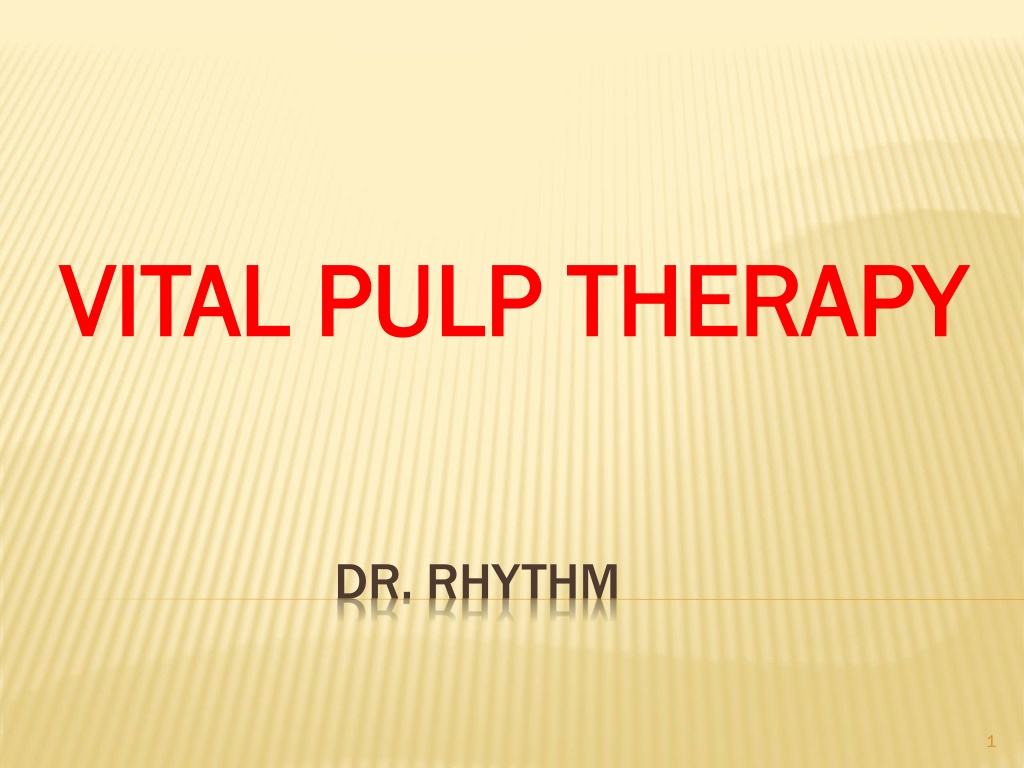
 undefined
undefined


